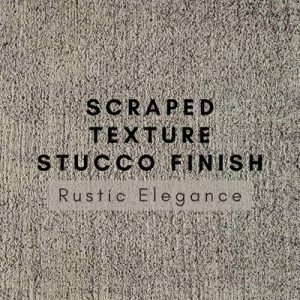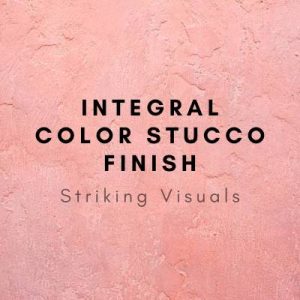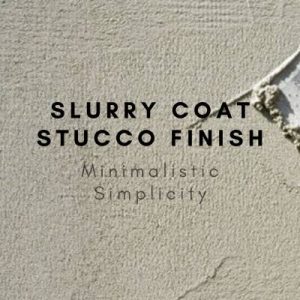Common Types of Stucco Finishes
Stucco is a versatile and popular exterior finishing material that adds beauty, durability, and a touch of elegance to any structure. One of the remarkable aspects of stucco is the wide range of finishes available, allowing homeowners and builders to achieve various aesthetic effects. In this article, we will delve into the captivating realm of the different types of stucco finishes, exploring different types, their characteristics, and the unique appeal they bring to architectural designs.
Different Types of Stucco
Classic Smooth Stucco Finish

The smooth stucco finish, as the name implies, provides a sleek and polished appearance to exterior stucco surfaces. Achieved by applying several layers of stucco and carefully troweling them to create a flat, seamless texture, the smooth texture exudes a timeless elegance. This finish is commonly seen in modern homes and outdoor living, emphasizing clean lines and minimalist aesthetics.
Coarse Sand Stucco Finish

The coarse sand finish adds a sense of texture and depth to stucco surfaces. By incorporating coarse sand into the stucco mix, this finish creates a subtle granular appearance. The coarse sand finish is popular for achieving a rustic or Mediterranean look reminiscent of traditional European architecture.
Spanish Lace Stucco Finish

The lace or Spanish lace finish is a delicate and intricate stucco design that harks back to the Old-World charm. This finish involves creating a pattern of interwoven lines and curves, resembling lacework, on the stucco surface. The lace finish is perfect for adding a touch of vintage elegance to buildings, particularly those with Spanish or Mediterranean influences.
Cat Face Stucco Finish

The cat face finish is a unique stucco finish that combines smooth surface and textured elements, creating an eye-catching effect. This finish involves applying a base layer of smooth stucco and then using a trowel to create irregular, shallow depressions. These depressions resemble the face of a cat, hence the name. The cat face finish adds character and visual interest to buildings, making it a popular choice for various architectural styles.
Pebble Dash Stucco Finish

The pebble dash finish is an excellent option for adding texture and visual intrigue to stucco exteriors. This finish involves throwing small pebbles or crushed stones onto the wet stucco surface, allowing them to adhere and create a rough texture. The pebble dash finish is widely used in coastal regions or areas with a natural, earthy aesthetic.
Exposed Aggregate Stucco Finish

The exposed aggregate finish showcases the natural beauty of the underlying aggregates used in the stucco mix. After the initial stucco application, the top layer is carefully removed, exposing the aggregates such as pebbles, shells, or colored stones. This finish creates a visually striking effect, particularly when combined with contrasting aggregates.
Scraped Texture Stucco Finish

The scraped texture finish is a classic stucco finish that exudes rustic charm. This finish involves using a trowel or scraping tool to create irregular lines and grooves on the stucco surface. The scraped texture finish adds a sense of depth and character to buildings, making it a popular choice for traditional and craftsman-style homes.
Dash Stucco Finish

The dash finish, also known as the roughcast or spatter dash finish, is achieved by throwing stucco mix onto the wall surface using a brush or a special dash gun. This technique creates a mottled texture with small, protruding stucco bits. The dash finish provides a unique, textured appearance that works well with a range of architectural styles.
Trowel or Skip Trowel Stucco Finish

The trowel or skip trowel finish is a hand-applied technique that creates a textured, artisanal look. Using a trowel, the stucco is applied unevenly, leaving various thicknesses and patterns on the surface. This finish allows for artistic expression and customization, making it a favored choice for homeowners seeking a distinctive stucco appearance.
Smooth Sand Stucco Finish

The smooth sand finish combines the sleekness of a smooth finish with the subtle texture of sand. Fine sand is mixed into the stucco, creating a slightly grainy texture that adds visual interest without overpowering the overall appearance. This finish is popular in modern and contemporary architectural designs, providing a refined and contemporary look.
Accented or Integral Color Stucco Finish

The accented or integral color finish involves adding pigments or color additives directly into the stucco mix, resulting in a uniform color throughout the stucco surface. This finish allows homeowners and designers to achieve vibrant or subtle color variations, enhancing the visual appeal of the building’s exterior. The accented color finish is an excellent choice for creating a striking and customized appearance.
Santa Barbara Stucco Finish

The Santa Barbara finish is an iconic stucco finish that reflects the essence of Mediterranean and Spanish architectural styles. This finish combines smooth and textured elements, with the stucco surface lightly textured and troweled to create a weathered appearance. The Santa Barbara finish adds warmth and character to buildings, evoking a sense of rustic elegance.
English or Tudor Stucco Finish

The English or Tudor finish is reminiscent of the architectural styles found in England and Europe. This finish involves using a trowel to create irregular horizontal and vertical lines on the stucco surface. These lines are then partially scraped away, resulting in a textured and patterned appearance. The English or Tudor finish adds a touch of old-world charm and sophistication to buildings.
Engraved or Etched Stucco Finish

The engraved or etched finish is a modern and creative approach to stucco finishes. This finish involves carving patterns or designs into the stucco surface using specialized tools. The engraved finish allows for customization and artistic expression, making it a popular choice for contemporary homes or commercial buildings seeking a unique and visually striking appearance.
Slurry Coat Stucco Finish

The slurry coat finish is a simple yet effective stucco finish that involves applying a thin, smooth layer of stucco over the existing surface. This finish provides a clean and uniform appearance, enhancing the aesthetics of buildings with a minimalist design. The slurry coat finish can also be used as a base for other stucco finishes, creating a versatile foundation for customization.
Synthetic Stucco vs. Traditional Stucco
Synthetic stucco, also known as Exterior Insulation and Finish System (EIFS), and traditional stucco, are two different types of stucco exterior wall finishes with notable differences.
Traditional Stucco
Traditional stucco, also called cement stucco, is a mixture of cement, sand, and water. It has been used for centuries and is known for its durability and strength. Traditional stucco is applied directly to the wall substrate, such as masonry or wood, and consists of multiple layers, including a scratch coat, brown coat, and finish coat. The finish coat is often textured and can be painted.
Synthetic Stucco
Synthetic stucco is a multi-layered system consisting of a foam insulation board attached to the wall substrate, a base coat reinforced with fiberglass mesh, and a textured finish coat. The base coat is usually made of acrylic or polymer, giving it flexibility and crack resistance. Unlike traditional stucco, synthetic stucco is not directly applied to the substrate but rather adheres to the foam insulation board.
One of the key advantages of synthetic stucco is its insulation properties. The foam insulation board improves energy efficiency by reducing heat transfer and increasing the building’s thermal resistance. Traditional stucco, while providing some insulation value, is not as effective as synthetic stucco in this regard.
Another difference is the flexibility of synthetic stucco. The polymer or acrylic base coat allows for greater flexibility, making it more resistant to cracking caused by building movement or temperature changes. Traditional stucco, although durable, may develop cracks over time due to its rigid composition.
In terms of aesthetics, both types of stucco offer a variety of finishes and textures. However, synthetic stucco provides more design options since it can be easily shaped and molded during application.
While traditional stucco is a time-tested, durable option, synthetic stucco offers enhanced insulation, flexibility, and a broader range of design possibilities. The choice between the two depends on factors such as climate, budget, and desired performance characteristics.
How to Hang Things on Stucco

Attaching objects or hanging Christmas lights on stucco walls requires special care to prevent damaging the wall.
Check the Weight of the Object
This is crucial because if the object is too heavy, you might need to find the wall studs behind the stucco and use those to secure the object. A standard stud detector can help locate studs, but remember it might be less effective through a stucco wall. The stucco itself can support objects of lesser weight.
Choose the Right Hardware
For lightweight objects, adhesive hooks or double-sided tape designed for outdoor use may be sufficient. For heavier objects, you will need more robust hardware. Concrete screws, such as Tapcon, can be used. When using screws, make sure to use a screw length that can go through the stucco and into the wood or masonry underneath for a secure fit.
Mark the Spot
After determining where you want to hang the object, mark the spot with a pencil. Make sure it’s level.
Drilling a Hole
Use a masonry bit to drill a hole into the stucco. If you’re using screws, the hole should be smaller than the diameter of the screws. Apply gentle pressure when drilling to avoid cracking the stucco.
Insert the Screw or Anchor
If you are using an anchor, push it into the hole first. Then, drive the screw into the anchor. If you’re using a concrete screw, you can drive it directly into the hole. Always be sure not to overtighten, as this can cause the stucco to crack.
Attach the Object
Finally, attach your object to the screw or hook. Ensure it’s securely fastened and leveled.
Clean Up
Clean up any dust or debris caused by the drilling process.
Please note that you should always follow the manufacturer’s instructions for any hardware or tools you use. And remember to wear protective gear when drilling into stucco to protect your eyes and lungs.
Last Notes
Stucco finishes offer many options to suit diverse architectural styles and personal preferences. From smooth and sleek to textured and rustic, each finish brings its own unique appeal to the exterior of buildings. By understanding the characteristics and aesthetics of different stucco finishes, homeowners and builders can make informed choices, creating visually stunning and enduring facades that stand the test of time. Embrace the artistry and versatility of stucco finishes and transform your building into an architectural masterpiece.




